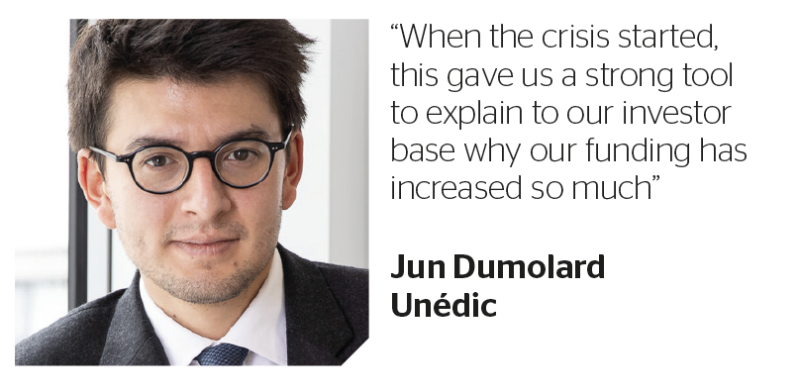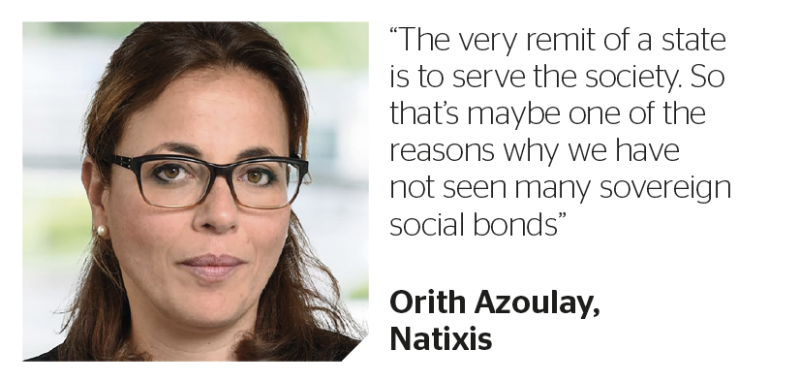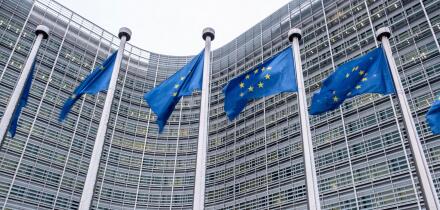Before the onset of the pandemic, social bonds were a niche product for borrowers. The growth over the years was at best, steady. In 2017, there was $10bn of issuance, followed by $14bn in 2018 and $38bn in 2019. But in 2020, that number is forecast to reach an incredible $140bn.
Public sector borrowers have been at the forefront in the rise of social bond issuance this year. The biggest issuer by far was the European Union, which raised €39.5bn for its Support to Mitigate Unemployment Risks in an Emergency (SURE) fund, all through the sale of social bonds.
“2020 has seen the rise of social bonds in a large part due to the pandemic, where many issuers, particularly SSAs, realised that they could finance Covid-related expenses in a very targeted way,” says Robert Vielhaber, director, sustainable finance advisory at UniCredit in Munich. “Investors have welcomed the opportunity to direct capital towards these bonds in order to play their part in fighting the pandemic. It’s the perfect tool at the right time.”
Pure social players
But the EU has not been alone. Other big debut issuers of social bonds in 2020 included the likes of France’s Caisse d’Amortissement de la Dette Sociale (Cades) and Unédic.
Cades and Unédic are pure social players with the proceeds of their funding going towards supporting the unemployed and the social security system in France.
“We have a lot of pure social players but in the green bond space, there are almost no pure players,” says Tanguy Claquin, head of sustainable banking at Crédit Agricole CIB in London.
For Unédic, a move towards issuing social bonds was always the plan.

“We had the mandate to issue social bonds in June 2019 — before the crisis — so we had been thinking about adapting our funding with social bonds,” says Jun Dumolard, chief financial officer at Unédic in Paris. “But when the crisis started, this gave us a strong tool to explain to our investor base why our funding has increased so much.”
Unédic started with a funding programme of €4bn for 2020 but ended up raising €19bn in medium and long term debt, of which €17bn was raised with the issuance of social bonds.
There were numerous other debut social bond issuers in 2020, including Municipality Finance, which became the first borrower in Finland to issue a bond in the format in September.
Like Unédic, MuniFin was also planning a move to social bonds for some time.
“It had been on our agenda for the last two or three years,” says Antti Kontio, head of funding at MuniFin in Helsinki. “We always felt social was an integral part of our business model and what we do alongside green. We went with green bonds first as it is easier to understand the impact.
“The timing was very good because there has been a clear move towards social bonds this year. We only issued a €500m transaction but the book grew to €1.9bn and we were also able to tighten the price to fair value.”
Virtuous social bond circle
Developing a dedicated investor base in a themed bond market needs a dedicated supply of deals. You need a big volume of themed bonds to encourage investment strategies and once the strategies are in place that will encourage issuers to do more themed bonds.
But despite the amount of social bond supply in 2020, there is not yet a mature and dedicated social bond investor base like there is for the green bond market.

“When the green bond market developed eight years ago, we had almost no dedicated green bond funds,” says Pierre Blandin, head of sovereign, supranational and agency debt capital markets at Crédit Agricole CIB in London.
“So you could assume with the development in the issuance of social bonds, we could see more dedicated social bond funds. But in addition to that, there is a huge pool of cash investing in social bonds by more general ESG [environmental, social and governance] funds.”
Orith Azoulay, global head of green and sustainable finance at Natixis in Paris, points out that there are only three social bond funds in the market and they are managed by one single investor, Columbia Threadneedle Investments. “But what we’re seeing is the rise of sustainable bond funds, and there have been a few examples of these funds being created this year with a very significant size of assets under management,” she says.

“There are sustainable bond funds that only buy labelled bonds — green, social or sustainable. Or there are sustainable funds that initially were set to invest on the basis of the ESG ratings of an issuer or of SDG [sustainable development goals] screenings. But the latter have also been investing quite massively over the last few years in labelled bonds.”
A number of green bonds funds have also been buying social bonds.
“In April, Italian government agency Cassa Depositi e Prestiti came to the market with a Covid-19 social response bond and after the deal we found out that an Italian fund had bought the issuance for its green bond fund,” says Vielhaber.
“It was the first time we had seen a dedicated green fund in the order book of a social bond. A number of portfolio managers have since done the same thing.”
Sovereign social bonds?
In addition to a dedicated investor base, the social bond market also needs a more diverse range of issuers to help the asset class grow even further, such as sovereigns.
Ecuador issued the world’s first sovereign social bond in 2020, using the proceeds to fund affordable housing. This was followed up by a Covid-19 response bond from Guatemala. But there has yet to be a deal in the format by a European sovereign.
“It’s only a matter of time,” says Claquin. “If you look at the expenditures managed by a state, they are an obvious social bond issuer.”
So what’s the hold-up?
“If you look at the largest sovereigns that are active in the green bond market, almost everything under their budget with the exception of the defence budget can be construed as social,” says Blandin. “So the question is how do you define what can be financed by social bonds under the Social Bond Principles? It’s a bit tricky.”
Azoulay agrees. “A number of sovereigns by definition have social expenditures as part of their mission, so the selection of social expenses in a given budget can be challenging,” she says. “The very remit of a state is to serve the society. So that’s maybe one of the reasons why we have not seen many sovereign social bonds.”
The other concern is that for some countries, social debt has to be financed with tax, so there could also be legal hurdles for sovereigns issuing social bonds.
If sovereigns are able to overcome these obstacles, there could be a benefit to issuing social bonds, particularly for the smaller sovereigns who struggle to find enough eligible green assets to do a green bond.
Measuring the impact
Another factor holding back the development of the social bond market is the concern around measuring impact.
“Green is easier to understand than social, which is more abstract,” says Kontio. “So there needs to be some kind of clear guidance on the impact of social bonds. For green, everyone wants to know about CO2 emissions but we don’t yet have the same metric for social.”
Do we need a social taxonomy? Kontio doesn’t think so. “We need to see how the market develops over the next few years first. But for the time being, we need some clear understanding on what is social.”
Azoulay adds: “Of course, common language and standardisation is super-welcome. But a taxonomy is not going to solve the main issue, which is measuring the social impact. Until now, we haven’t seen any controversy in social proceeds like we have in green.”
Perhaps the best way to measure the impact of social bonds is by looking at the impact on people such as patients, students and tenants.
“Before the pandemic, people thought of social bonds as having a target population,” says Vielhaber. “Covid-19 effectively means that the target population is everyone, broadening the scope of the instrument.”
Nevertheless, the social bond market will continue to grow in size next year.
“We expect social bond issuance volume to increase in 2021, primarily due to EU activity,” says Vielhaber. “The likes of Cades and Unédic will also help support the market in this manner.”
Could social bond issuance overtake green? Azoulay doesn’t think so, in the short term at least. “I don’t see social bond issuance overtaking green bonds in the foreseeable future,” she says. “It will be some time before we even have a balanced picture. The [EU’s] Next Generation funding will lead to a significant bias towards green issuance next year.” GC






